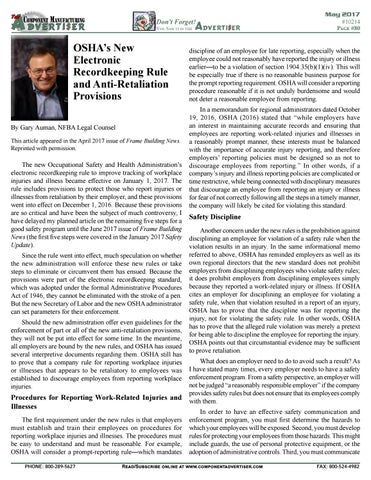A
Th e
Component Manufacturing dverti$er
You Saw it in the
OSHA’s New Electronic Recordkeeping Rule and Anti-Retaliation Provisions By Gary Auman, NFBA Legal Counsel This article appeared in the April 2017 issue of Frame Building News. Reprinted with permission.
The new Occupational Safety and Health Administration’s electronic recordkeeping rule to improve tracking of workplace injuries and illness became effective on January 1, 2017. The rule includes provisions to protect those who report injuries or illnesses from retaliation by their employer, and these provisions went into effect on December 1, 2016. Because these provisions are so critical and have been the subject of much controversy, I have delayed my planned article on the remaining five steps for a good safety program until the June 2017 issue of Frame Building News (the first five steps were covered in the January 2017 Safety Update). Since the rule went into effect, much speculation on whether the new administration will enforce these new rules or take steps to eliminate or circumvent them has ensued. Because the provisions were part of the electronic recordkeeping standard, which was adopted under the formal Administrative Procedures Act of 1946, they cannot be eliminated with the stroke of a pen. But the new Secretary of Labor and the new OSHA administrator can set parameters for their enforcement. Should the new administration offer even guidelines for the enforcement of part or all of the new anti-retaliation provisions, they will not be put into effect for some time. In the meantime, all employers are bound by the new rules, and OSHA has issued several interpretive documents regarding them. OSHA still has to prove that a company rule for reporting workplace injuries or illnesses that appears to be retaliatory to employees was established to discourage employees from reporting workplace injuries.
Procedures for Reporting Work-Related Injuries and Illnesses The first requirement under the new rules is that employers must establish and train their employees on procedures for reporting workplace injuries and illnesses. The procedures must be easy to understand and must be reasonable. For example, OSHA will consider a prompt-reporting rule—which mandates PHONE: 800-289-5627
Adverti$er
Don’t Forget!
May 2017 #10214 Page #80
discipline of an employee for late reporting, especially when the employee could not reasonably have reported the injury or illness earlier—to be a violation of section 1904.35(b)(1)(iv). This will be especially true if there is no reasonable business purpose for the prompt reporting requirement. OSHA will consider a reporting procedure reasonable if it is not unduly burdensome and would not deter a reasonable employee from reporting. In a memorandum for regional administrators dated October 19, 2016, OSHA (2016) stated that “while employers have an interest in maintaining accurate records and ensuring that employees are reporting work-related injuries and illnesses in a reasonably prompt manner, these interests must be balanced with the importance of accurate injury reporting, and therefore employers’ reporting policies must be designed so as not to discourage employees from reporting.” In other words, if a company’s injury and illness reporting policies are complicated or time restrictive, while being connected with disciplinary measures that discourage an employee from reporting an injury or illness for fear of not correctly following all the steps in a timely manner, the company will likely be cited for violating this standard.
Safety Discipline Another concern under the new rules is the prohibition against disciplining an employee for violation of a safety rule when the violation results in an injury. In the same informational memo referred to above, OSHA has reminded employers as well as its own regional directors that the new standard does not prohibit employers from disciplining employees who violate safety rules; it does prohibit employers from disciplining employees simply because they reported a work-related injury or illness. If OSHA cites an employer for disciplining an employee for violating a safety rule, when that violation resulted in a report of an injury, OSHA has to prove that the discipline was for reporting the injury, not for violating the safety rule. In other words, OSHA has to prove that the alleged rule violation was merely a pretext for being able to discipline the employee for reporting the injury. OSHA points out that circumstantial evidence may be sufficient to prove retaliation. What does an employer need to do to avoid such a result? As I have stated many times, every employer needs to have a safety enforcement program. From a safety perspective, an employer will not be judged “a reasonably responsible employer” if the company provides safety rules but does not ensure that its employees comply with them. In order to have an effective safety communication and enforcement program, you must first determine the hazards to which your employees will be exposed. Second, you must develop rules for protecting your employees from those hazards. This might include guards, the use of personal protective equipment, or the adoption of administrative controls. Third, you must communicate
Read/Subscribe online at www.componentadvertiser.com
FAX: 800-524-4982
